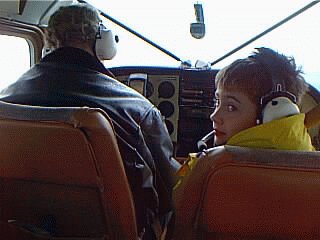A Project-Based, Student-Inspired Curriculum

Core Subject Areas and Resources
The core curriculum takes advantage of the following technology and teaching resources:- A 4 credit University-level aviation ground school (Aviation Technology 100 at the University of Alaska Southeast)
- Jeppesen Aviation Training Materials
- Textbook: Private Pilot Flight Manual (Guided Flight Discovery)
- CD ROMs: Private Pilot Multimedia Training
- Videos: Private Pilot Maneuvers
- Computer-Based Flight simulators
- Dual Control Flight time, with certified flight instructor
- Certified Ground Instructor Consultation (as needed)
Aviation ground school contains a large amount of inherent math problems (speed-time-distance, weight and balance) that mesh with or exceed the 5th grade JSD CORE standards in mathematics. Aerodynamics (physics) and meteorology provide a firm science exposure. Sixth grade middle-school math teachers will also be consulted to determine what specific areas may need further development prior to the student entering middle school.
Because this is the first lecture-format class taken by this student, parents will be very involved in the curriculum to provide additional support and resources for the student.
Assessment: The aviation ground school class provides a midterm and final examination. When ready, the student anticipates taking the FAA written knowledge exam for private pilots.
Other Subject Areas (Primarily Outside Core Project)
- Language Arts: Reading and Writing Skills.
-
Reading. A primary and current need for this student is a large amount of reading time.
Directed reading under pressure for school projects or with too much guidance
has been less productive in developing these skills than we would like.
For the duration of this project,
the student will be encouraged to read in subjects of his own choosing and interests
in an attempt to stimulate his interest in reading.
Assessment: Maintain completed Reading list. Discussions with student during and after each book to assess comprehension, plot and character development.
-
Writing and Composition.
Keyboarding skills will be further developed and informal writing such as
correspondence will be encouraged to further composition skills.
This student writes slowly and has a sense of perfection that has inhibited
his willingness to revise his draft compositions.
Keyboarding skills and drafting and editing in word processors could benefit
this student. The student has a number of distant potential correspondence
contacts and could benefit from developing routines of email correspondence.
Creative writing techniques in other curricula will be investigated to help
round out this area.
Assessment: Keyboarding assessment is integral in software package (Mavis Beacon Teaches Typing). Writing composition will be evaluated by parents.
-
Reading. A primary and current need for this student is a large amount of reading time.
Directed reading under pressure for school projects or with too much guidance
has been less productive in developing these skills than we would like.
For the duration of this project,
the student will be encouraged to read in subjects of his own choosing and interests
in an attempt to stimulate his interest in reading.
- Social Studies:
- History. The student has developed an intense interest in the World War II era, related to his aviation interests, and is already very knowledgeable in this area. Much of his self-selected reading is currently in this era. Broader American history studies will be provided such that the student has a basic grasp of Alaskan and American history consistent with the Juneau School District CORE standards for 5th grade.
- Fine Arts.
- Music. Joe has been enrolled in a Suzuki violin program for the past two years
and has advanced to the end of Suzuki Book 1. He will continue the JCCS Suzuki
violin program, if possible, or else continue violin lessons separately, on his own.
Assessment: Public performance recitals (videotaped).
- Art. Joe may attend art classes at DZ, where his mother teaches art, if possible, or other arrangements will be made.
- Music. Joe has been enrolled in a Suzuki violin program for the past two years
and has advanced to the end of Suzuki Book 1. He will continue the JCCS Suzuki
violin program, if possible, or else continue violin lessons separately, on his own.
- Physical Education: Indoor league soccer (2 hours per week) and other activities.